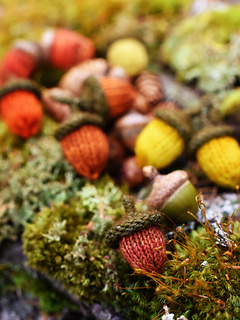patterns >  Tiny Nonsense
Tiny Nonsense
> Hoard








Hoard
These win the prize for the quickest and very possibly the most ridiculous thing I’ve ever knit (though to be fair, there is a good bit of competition for that last category). It’s also the thing I’ve knit the most times. By, oh, let’s just say by a rather substantial margin. I think I knit a dozen in an afternoon when the urge first came upon me.
For you see, there is a massive oak tree in my yard. And I’ve rather bonded with this tree. I see it out my office window all day long, and I love it dearly. Every year it drops absolute masses of double acorns. One fall, as I was spending some time with the tree, I noticed one tiny, gleaming acorn hanging out in a little pocket of moss nestled in the space between two tree roots.
It was unspeakably perfect, the sort of thing you see on a postcard and think it’s just a bit too charming to ever be real. So naturally I started wondering what it would look like with a knitted acorn. And then, well, you know what happens when I get an idea like that.
The pattern originally had you use real acorn caps for the tops of each acorn, and I’m still awfully fond of this approach. But I was eventually overcome by the urge to do a knitted version of the acorn cap (yes, yes absolutely including a double version, how could I resist), so now the pattern includes both options.
There’s absolutely nothing practical to do with them at all. They serve no useful function whatsoever. But I suspect you’ll find them every bit as irresistible as I do. Though I’ll warn you, it’s shockingly difficult to knit just one.
General information
This 22-page pattern is tremendously detailed and holds your hand every step of the way. There are pages and pages of step-by-step photos to show you exactly what to expect as you work. The pattern is full of helpful tips on everything from casting on, blocking, filling your acorns, and managing your ends.
It’s almost absurdly detailed, but it really does mean you can totally make these, even if you’ve never knit a project like this before!
Skills & scope
Each acorn is about the size of the tip of your thumb and takes only a few minutes to knit. You’ve got options for using real acorn caps or knitting your own, and you can make the knitted ones as either single or double acorns.
Yarn, gauge & sizing
The acorn comes in five sizes, the cap in three. You can make it in any weight of yarn, and the finished size will change depending on what yarn you use (but they’re more or less the size of real acorns). You don’t need to match any particular gauge, but you do need to knit tightly enough to make a firm fabric so your filling doesn’t show through.
I’ve knit this in everything from fingering-weight up through bulky-weight yarns.
You can absolutely use scrap yarn for this.
The acorns in the pictures took less than 25 yards of yarn for each acorn and each acorn cap. They are worked between 9 stitches per inch (for the fingering-weight yarn) and 6 stitches per inch (for the bulky-weight yarn). They are between 1 and 1.5 inches tall and 0.5 and 1 inches across.
Tools & supplies
You’ll need needles that let you work in the round (circulars or DPNs) in whatever size lets you get a firm fabric with your chosen yarn plus the general knitting tools you need for most projects (scissors to cut your yarn, a darning needle to weave in ends, the occasional stitch marker or bit of scrap yarn to hold stitches).
You’ll also need something to fill the acorns with. If you want to use real caps (instead of knitted ones), you’ll need those too. I have a page here with information about the supplies I use in my projects.

- First published: October 2018
- Page created: October 12, 2018
- Last updated: March 31, 2025 …
- visits in the last 24 hours
- visitors right now





